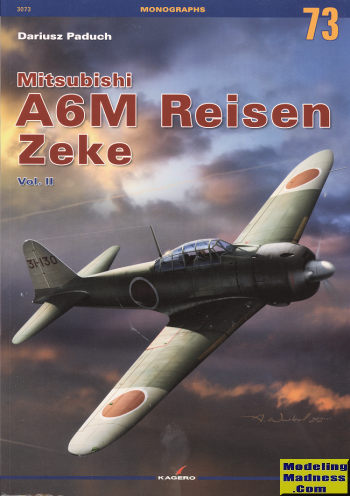Kagero's A6M Reisen Vol. 2
 One of the
more popular Japanese fighters of WWII was the A6M 'Zero'. The aircraft took
'those who know' by surprise as it was felt that the Japanese were incapable of
producing world class aircraft. Obviously the 'experts' were not paying
attention and were ignoring reports from the far east regarding Japan's war with
China and the Soviet Union.
One of the
more popular Japanese fighters of WWII was the A6M 'Zero'. The aircraft took
'those who know' by surprise as it was felt that the Japanese were incapable of
producing world class aircraft. Obviously the 'experts' were not paying
attention and were ignoring reports from the far east regarding Japan's war with
China and the Soviet Union.
The A6M was born of a set of requirements
that no one thought could be reached. The combination of maneuverability, rate
of climb, speed and endurance were felt to be too much. Too bad no one told Jiro
Hirokoshi, the main designer of the aircraft. Through the use of lightweight
materials and construction, he was able to get the most out of Japan's
relatively low powered radial engines. In addition, the speed, rate of climb and
especially endurance were exceeded.
This second volume continues where the
first left off with the development of the A6M3. This aircraft had a more
powerful engine than the earlier A6M2, but was in most respects, the same
airframe. In order to improve the aircraft's performance, the folding wing tips
were replaced with wooden inserts, giving the type 32 a 'clipped' wing look.
This helped to improve the aircraft's climbing and diving speed but, due to the
more powerful engine, its range was reduced over the previous version. A nearly
identical type 22 was also produced that reinstated the folding wing tips. Many
of these planes operated from land bases
In addition to covering the development
of the aircraft, this volume also starts to cover the combat history of the A6M,
starting with operations in China and then moving to the Pacific. It goes all
the way until the Truk operations in 1944 so some of the later images are of the
later A6M5. This volume also covers operations of the A6M2-N floatplane fighter.
As well as the history of the aircraft,
there are scale plans of the A6M2-N in both 1/48 and 1/72 scale. You will also
find several pages of color profiles of some of the more interesting variations
regarding the camouflage schemes carried by these planes. Though not included
with this book, Kagero has also produced a decal sheet with some of these planes
on it. A real treat for many of us are some very nice photographs of these
planes, though how the author can make any sort of color and markings commentary
on some of them is beyond me.
In all, it is a great addition to the
Kagero line of books and I'm very much looking forward to what should be at
least one more volume. If you are a fan of the type, this is one you really should have on
your shelves.
July 2021
Copyright ModelingMadness.com. All rights reserved.
My thanks to
Casemate Publishing for the review
copy. You can get yours
at this link.
If you would like your product reviewed fairly and
fairly quickly, please contact
me or see other details in the
Note to
Contributors.
 One of the
more popular Japanese fighters of WWII was the A6M 'Zero'. The aircraft took
'those who know' by surprise as it was felt that the Japanese were incapable of
producing world class aircraft. Obviously the 'experts' were not paying
attention and were ignoring reports from the far east regarding Japan's war with
China and the Soviet Union.
One of the
more popular Japanese fighters of WWII was the A6M 'Zero'. The aircraft took
'those who know' by surprise as it was felt that the Japanese were incapable of
producing world class aircraft. Obviously the 'experts' were not paying
attention and were ignoring reports from the far east regarding Japan's war with
China and the Soviet Union.